Monday March 25 was hazy and humid with a high of 27C. We probably won't be saying that again until July! We decided to take the
I'm Free Local's Guide to Sydney Free Tours at 2:30 p.m. We had taken their free tour in Melbourne, which we had really enjoyed. Because we had time, we decided to walk to Town Hall, the meeting place, and explore some of the arcades located nearby.
We had our morning coffee at Jeremy & Sons, just a few doors down from our apartment. We then started our walk and passed a statue of Captain Cook in Hyde Park. It was erected in 1879 to mark the centenary of his death.
 |
| 1879 statue of Captain Cook. Sculptor was Thomas Woolmer, who was prominent in the English pre-Raphaelite movement and spent several years in Australia. |
We stopped for a moment to take a photo of Sydney Tower, the tallest structure in the City. It was completed in 1981 and is owned by Westfield, an international shopping centre developer.
 |
| Sydney tower - Auckland's is taller |
 |
| Banners for Sydney Dance Company-- we bought tickets for a performance on March 28 |
We passed a number of interesting buildings from the mid 19th century.
 |
| Bank of New South Wales building- 1871 |
 |
| W. H. Soul 1868 |
We wandered through The Strand Arcade, one of the first Victorian buildings in Sydney, which dates back to 1891.
 |
| Interior of the Strand |
 |
| Wonderful store in The Strand called Gewürzhaus Herb & Spice Merchants (also in Melbourne) |
We wandered into the Queen Victoria Building (known as the QVB), that we would return to on our tour.
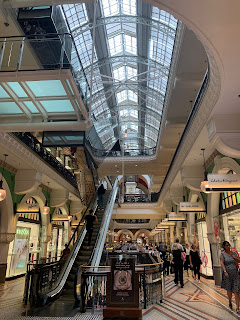 |
| Inside of the QVB |
We met at the Anchor Statue near the Town Hall. Our tour guide was Jake, a recent graduate in theatre and film studies. He was very enthusiastic and a good tour guide. He filled us in on the history of Sydney including its establishment as a penal settlement on January 26, 1788 by Captain Arthur Phillip.
 |
| Jake starting the tour |
Our guide stopped next at the Queen Victoria Building, which we had just briefly visited. The site has been under the control of the Council of the City of Sydney since 1842, when Sydney Town was incorporated.
The Romanesque Revival building was constructed between 1893 and 1898. It was designed by George McRae, a Scottish architect who had emigrated to Sydney in 1884. It was originally designed as a marketplace and then was used for a variety of other purposes, including the City of Sydney Library and the Electricity Department. The building began to deteriorate over time and in 1959 was threatened with demolition. Because the Sydney County Council occupied some of the space, this didn't happen and by the late 1960s there was a move for its preservation. From 1984-86, the building was restored by a Malaysian Company under the terms of a 99- year lease from the City. There was a major refurbishment done in 2008-09.
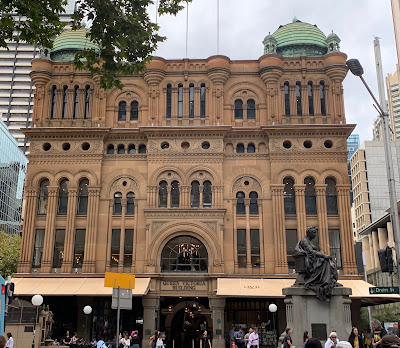 |
| Outside of the QVB |
 |
| Royal Clock in QVB |
Our guide told us that the Queen Victoria statue was not installed at the same time as the QVB opened. The statue had stood outside the Legislative Assembly of the Republic of Ireland in Dublin until 1947 when it was put into storage. It was later given to Sydney and placed on its present site in 1987! Our guide quipped that it was the last convict sent to Sydney!
 |
| Statue by Irish sculptor John Hughes |
As we were walking, we passed the St James railway station, a heritage-listed rail station at the northern end of Hyde Park. It opened in December 1926. It has a great old Neon sign from the late 1930s advertising Chateau Tanunda Brandy.
 |
| A quick glance into the St. James train station |
We went into Hyde Park (named after London's Hyde Park) and stopped at St. Mary's Cathedral, the largest Catholic Church in Sydney. The foundation stone for the first St. Mary's was laid in 1821. It was destroyed in a fire in June 1865. The foundation stone for the present cathedral was laid in 1868.
 |
| St. Mary's Cathedral |
Our guide pointed out the Archibald Fountain in Hyde Park. It was designed by French sculptor François Sicard (1862-1934) and commemorates the association between Australia and France in WWI. Its themes are from Greek antiquity and it is done in an Art Deco style.
 |
| Archibald Fountain opened March 1932-- named after J.F. Archibald, owner and editor of The Bulletin magazine who bequeathed funds to have it built. |
We stayed in the park for a while, and our Guide gave us some more details of the history of Sydney. The first convicts arrived in the First Fleet of 11 convict ships in 1788 and over the next 80 years, more than 160,000 convicts were transported to Australia from England, Ireland, Scotland and Wales. Convicts had originally been shipped to the American colonies but with the start of the American Revolution an alternative site had to be found. Britain chose Australia. Our guide said that in 1792, 92% of Sydney's population were convicts. Penal transportation peaked in the 1830s and dropped off after that date due to protests against the convict system. Many of the convicts were transported for petty crimes. Around 20% of modern Australians are descended from transport convicts. While once considered a stigma, it is now seen to be a source of pride to have a convict in one's lineage.
We passed a sculpture of Lachlan Macquarie (1762-1824), who was Governor of New South Wales (NSW) from 1810- 1821. Our guide pointed out that there are numerous buildings, a bank and a street named after Macquarie.
 |
| Major General Lachlan Macquarie, Governor of NSW |
 |
| Another Queen Victoria statue |
We stopped to look at the Hyde Park Barracks, built between 1811-19 as a compound to house convict men and boys. Governor Macquarie, after his arrival in Sydney became disturbed by convict behaviour in the streets after work. Convicts had been allowed to find their own lodgings. Macquarie thought that barracks accommodation would improve the moral character of the men. It was designed by the transported convict architect Francis Greenway to originally house 600 men. At one time, up to 1400 men were housed in the Barracks. Later, it became a form of punishment to have to live there. By 1848, it closed as a convict accommodation site. Eventually, it became a museum. The site is presently closed while a new exhibition space is being developed.
Francis Greenway (1777-1837) was an English-born architect who was transported to Australia for the crime of forgery. He had originally been sentenced to death, but his sentence was commuted to 14 years' transportation. In NSW, he worked for Governor Lachlan Macquarie, as Australia's first government architect, who emancipated him from his sentence in 1818, after he had completed a successful design and construction of a lighthouse. He fell into disrepute when Macquarie accused him of charging high fees and he was dismissed by the next governor in 1922. In 1835, he was destitute and died of typhoid in 1837.
 |
| Hyde Park Barracks - former convict accommodation- now a museum and café |
We stopped to see St. James' Church, an Anglican parish Church that was consecrated in 1824. It was designed in the style of a Georgian town church by Francis Greenway during the governorship of Lachlan Macquarie.
Greenway's face was shown on the first Australian decimal-currency $10 note (1966-93). Our guide pointed out that ironically he is perhaps the only convicted forger depicted on a banknote.
St. James' Church was constructed between 1820-24 using convict labour. Its original ministry was to the convict population and it has continued to serve the city's poor in succeeding centuries.
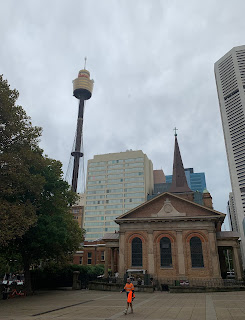 |
| Oldest church in Sydney's inner city region- this was once its tallest building |
We then stopped at the Sydney Hospital. It is the oldest hospital in Australia dating back to 1788 and has been at its current location since 1811. Upon his arrival in NSW in 1910, Governor Macquarie discovered that the hospital only consisted of a number of tents and temporary buildings. He set aside land. Plans were drawn up but the British Government refused to provide funds to built the hospital.
Macquarie then entered into a contract with a consortium of businessmen to erect the new hospital. Their reward was a monopoly on rum imports from which they would recoup the costs of the hospital and gain profits. It became known as the "Rum Hospital". As it was nearing completion in 1815, the now famous convict architect Francis Greenway was asked to report on the quality of the work. He condemned it, claiming it would fall into ruin. It had many defects and repairs were needed in the 1920s. A more substantive restoration took place in the 1980s.
 |
| Sydney Hospital-- main building still in use |
We then stopped at the Sydney siege memorial in Martin Place. We had forgotten about this incident, but in 2014, a man held 17 people hostage for more than 16 hours at the Lindt Cafe in Sydney's CBD. Two of the hostages and the gunman died. In the days following the siege, the area was transformed by more than 100,000 bunches of flowers, inspiring the memorial which has 210 hand crafted flowers set into the ground and covered by glass. The memorial was unveiled in December 2017. A number of the favourite flowers of the two victims Tori Johnson (the Cafe manager) and Katrina Dawson, a lawyer, are embedded in the pavement.
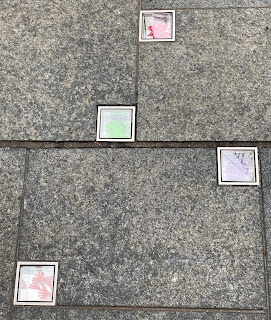 |
| Sydney siege memorial (hard to get good photos of the embedded flowers) |
 |
| Bank of Australia building |
We then stopped at another Memorial in Martin Place. The Sydney Cenotaph, which opened in 1927, has two bronze statues at either end of the monolithic stone block - a soldier and a sailor guarding it. One side says "To Our Glorious Dead" and the other side says "Lest We Forget." It is the centre for Sydney's Anzac Day ceremonies. The Cenotaph does not name individuals, but instead commemorates the communal sacrifice of lives lost at war. By the time of the Armistice in November 1918, 65% of those who had fought overseas had become casualties.
 |
| Sydney Cenotaph- one of the oldest WWI memorial |
 |
| Another view - located in front of the General Post Office (opened 1874 and functioned as the centre of NSW postal system until 1996-- part of the building is now a Hotel) |
We then went through a narrow alley and entered Angel Place, the site of a fabulous art installation of empty birdcages. The work is called
Forgotten Songs and was designed by Michael Thomas Hill and installed in 2012. As one stands under the birdcages you can hear the sounds of the birds that once inhabited Sydney before they were forced out by European settlement. As day becomes night, the sounds of the birds change too. There are 110 empty birdcages and speakers play the songs of 50 birds that used to live in the city before urbanization.
 |
| Forgotten Songs installation |
 |
"These recordings are from bird species that once lived in central Sydney, before the Europeans settled and gradually forced them away. Some of these birds can still be heard on the city margins
where they find food and shelter in native vegetation" |
There is signage in the pavement of the birds whose music is being heard.
We then went to Australia Square and visited with the "Waiting" sculpture by John Seward Johnson II (b. 1930), an American artist. It was created in 1988.
 |
| Reading the newspaper and "Waiting" |
We then headed down to Circular Quay and the harbour. We stopped in at the Customs House to see a model of the city.
 |
| Customs House- built 1845 |
We stopped to look at the Sydney Opera House. Our guide summarised its history--- construction started in 1959 and it opened in 1973. The Danish architect Jörn Utzon won a competition in 1957. However, the government insisted on a number of revisions. After the election of the Liberal Party in 1965, the relationship of client and architect became increasingly tense. By 1966, Utzon was owed more than $100,000 in fees and he could not pay his staff. He then resigned and left Australia, never to return.
A team brought the Opera House to completion. Peter Hall (1931-1995) took on the crucial role of design and guided the project to completion. In the late 1990s, the Sydney Opera House Trust resumed communication with Utzon is an attempt to effect a reconciliation and to secure his involvement in future changes to the building. In 1999, he was appointed by the trust as a design consultant for future work. In April 2007, he proposed a major reconstruction of the Opera Theatre, as it was then known. Utzon died in November 2008.
 |
| View of iconic Sydney Opera House |
 |
| Lots of these birds which the locals call "bin chickens" wandering around Sydney - real name is Australian white ibis. They forage in garbage bins. |
We wandered a bit in the Rocks area where Jake pointed out some interesting murals and museums in the neighbourhood. He also showed us where Friday-Sunday markets take place.
The Tour ended at the waterfront.
We noted a few more interesting entries on the Writers Walk in the pavement nearby.
 |
| Joseph Conrad weighs in on Sydney Harbour |
We decided to go to the Opera Bar for a drink before heading back to our apartment. There is a huge seating area outside. One orders drinks at a long bar under the walkway to the Opera House. Unfortunately, one cannot just walk into the Opera House unless taking a $40 tour or seeing a performance.
 |
| Alain on the walkway |
 |
| Moi aussi |
We got a beer and sat on a bench at the waters edge- all the tables were taken. At around 6:45 p.m. the clouds went away and the sun came out and there was fabulous light for about ten minutes just before the sun set at 7:00 p.m. Lots of people got out of their seats to take pictures.
 |
| Fab light at Sydney Opera House |
 |
| Harbour Bridge across the water |
 |
| We had just finished our drinks and asked a couple to take our picture |
We walked back to Circular Quay and took one last photo as the sun was setting. The lights on the other side of the waterfront were just coming on.
 |
Setting sun on the Harbour
We took the train back to the apartment for a salmon meal. We clocked around 18,000 steps on the day, but saw a lot of the City and learned more about its history.
|






































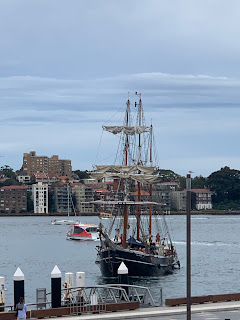


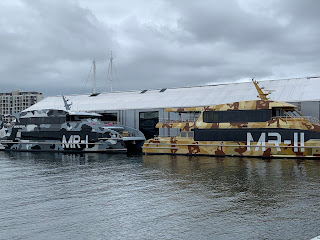

Comments
Post a Comment